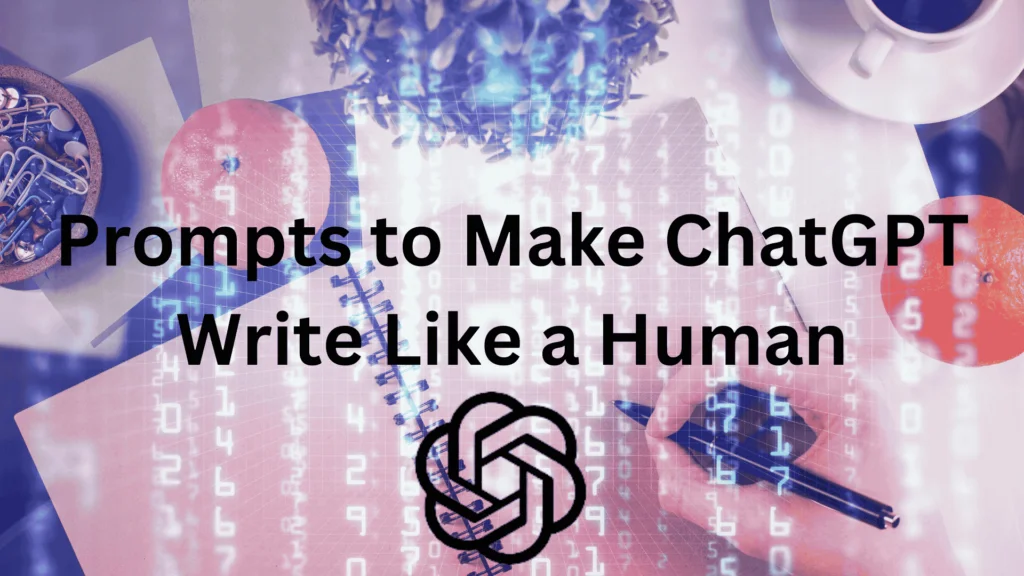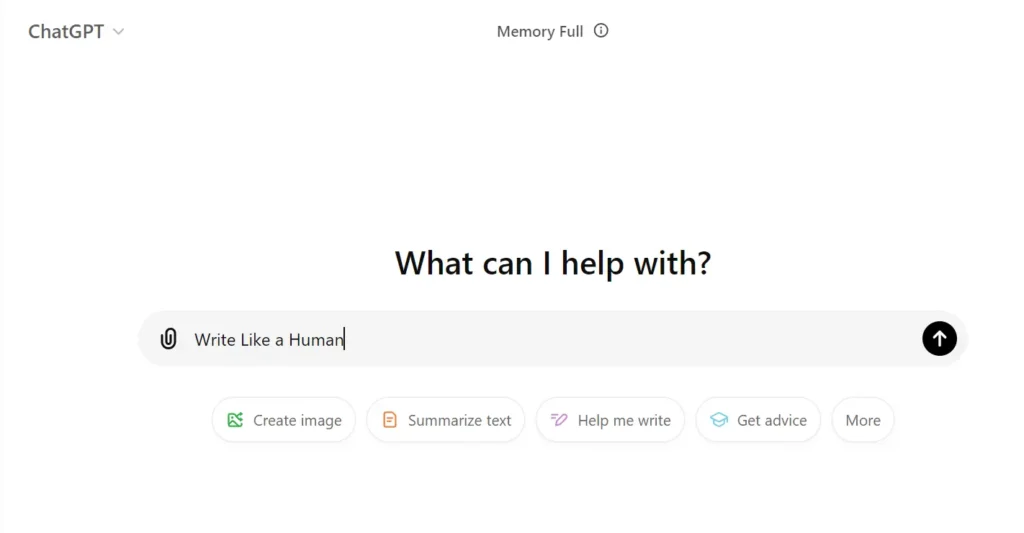Prompts to Make ChatGPT Write Like a Human
The Secret to Authentic AI Writing
With artificial intelligence being key to content creation., the demand for writing that feels more human has surged. Writers and entrepreneurs aim to adjust AI language for sounds that are fluent and authentic. This brings us to one of the hottest topics in AI-assisted writing: You can craft prompts to make ChatGPT write like a human using specific prompts.

You can surely make AI write in a human-like manner if you utilize the appropriate prompts and methods. This article will teach you to leverage AI properly while ensuring your writing is readable and true to life.
If you’re looking for humanizing AI content, you can learn about so here!
The Power of Prompts to Make ChatGPT Write Like a Human
The quality of AI depends on the prompts provided. Your input shapes the quality of the responses generated by ChatGPT. The quality of an AI-generated response is generally, or at least, strongly tied with the input which is often referred to as the “prompt”. Through a good development of the main prompt AI models such as ChatGPT can be guided to generate content that forms human conversational prose. This is particularly important when you want your content to have an emotional appeal to your target audience.

Primary Prompt Example:
“Write a friendly, conversational email inviting someone to a networking event. Focus on being engaging and personal.”
If you set clear prompts to make ChatGPT write like a human—such as “friendly,” “conversational,” and “personal”—you direct it to create text that feels more human.
However, this indicates only the start. Consider diving into intricate prompts to inspire ChatGPT to communicate in a human-like manner.
Refining Prompts for a Human Touch:
In other words, prompts do not have to be relaying general directions only. If you want the AI to take on a particular attitude or viewpoint, you can provide it with precedent information to focus on finer points. For instance:
- “Write an introduction for a blog post that is friendly, and informal but also engaging. Keep your language simple and share ideas in short sentences that people can easily understand.”
- “Write an exciting product description for [product name], avoiding business-formal language and focusing on a warm and familiar tone.”
These prompts allow the AI to generate text that is more natural in terms of style and tone, while still being informed by the AI, and rid of the formality that AI-generated text normally possesses.
Crafting Conversational Tone with Prompts to Make ChatGPT Write Like a Human
Often authors create content that flows well and uses simple sentences. These elements create content that is both clear and human-like. Here are some effective prompts to refine ChatGPT’s style:
Prompt: “Write a blog post introduction using a conversational tone, with short sentences and relatable language.”
Prompt: “Create an engaging product description for [your product], using casual, friendly language.”
Avoiding overly formal or robotic language is important. You avoid requesting formal definitions or detailed expressions. Emphasizing relatability and brevity creates a natural tone.
Avoiding Detection: Does Undetectable AI Work?
Some people doubt if AI writing can really go unnoticed. That brings us to a hot debate: Does undetectable AI work? The simple answer is: This outcome varies based on your direction of the AI.
AI tools such as StealthGPT assert that they can blend AI-created work with human-authored text. How dependable is their real use in practice? Does it work to alter AI-generated content to make it human-like?
Tools like AI paraphraser undetectable and StealthGPT usually work effectively when they can replicate the subtle traits of human writing like emotions and quirks. These tools shift AI-generated content to give it a more human feel. In some situations these tools greatly enhance content quality; however, perfection is tricky for AI-written texts.
Key Elements of Human-Like AI Writing
If you’re looking to humanize your AI content without relying solely on tools, here are some essential tips and prompts to make ChatGPT write like a human:
1. Include Emotions and Opinions
Our narratives become engaging because we convey emotions and perspectives. If AI receives the right instructions it can reflect this feature.
Prompt: “Write a review for [product] that expresses excitement and enthusiasm, as if you personally loved using it.”
Incorporating subjective beliefs and emotional feelings draws AI closer to human-like expression.
2. Use Imperfections
Strong grammar and organization frequently reflect artificiality. We all have sentences that deviate from perfect structure and infuse language with slang. These features add realness to the text.
Prompt: “Write an email to a friend, keeping the tone casual and even including some informal language or slight grammar slips.”
Minor flaws give AI-generated text a human touch.
3. Inject Personality
No matter who the writer is; AI can develop a unique expression just like them. Encouraging personality through a prompt is key for producing meaningful writing with ChatGPT.
Prompt: “Write a funny product description for [product], using puns and playful language.”
Encouraging ChatGPT to play with the content tends to create more appealing results.

4. Simplify Your Language
What seems most apparent is that AI is inclined to opt for the more sophisticated way of putting a sentence or using difficult words. By specifying that it should use simple language, you are more likely to dispel the stilted find and reach a more authentic looking conclusion.
Prompt: “Please write a guide to [complex topic] telling all you [know] as you would share with a friend.”
5. Encourage Short Sentences
More often than not, people use short simple sentences while working at the same time using short simple words when they are not being formal.
Prompt: “Besides, it would be better to use short sentences in the text to create readers’ interest and avoid possible misunderstanding.”
The Role of AI Humanizers: Do AI Humanizers Work?
StealthGPT AI endeavor to support marketers and companies in dodging AI detection tools. But do AI humanizers work?
These platforms are intended to refine AI-written material by adding layers that are more difficult to identify as inorganic. No tool is completely invincible. The secret lies in how creatively you train the AI from the outset. Therefore by merely passing an AI-based text through a humanizer tool it is not always guaranteed to avoid being detected as automated content.
You must prioritize the way you lead ChatGPT from the outset to achieve success. Cultivate precise prompts with diversity and guide the AI to flow more like human writing.
Paraphrasing: Does Humanize AI Work?
A common practice is to utilize AI paraphraser undetectable tools to alter text so that it gets through AI identification tests. But again, the question arises: Does humanize AI work? This approach fits when you utilize tools that hide their origins. The quality of the prompt and how the content is reworded determine the effectiveness.
Here’s a practical way to improve AI paraphrasing:
Prompt: “Rewrite this paragraph to sound more casual and relatable while keeping the original meaning intact.”
When you instruct ChatGPT to paraphrase in a desired manner it often results in a more genuine response that is easier to tell isn’t AI-driven.
Best Strategies for AI Humanization
While the tools and tricks are useful, here are a few golden rules to ensure your AI-generated content sounds as human as possible:
Edit for Nuance
Compared to human writing, AI too often doesn’t take into account minor differences in the length of the sentences or idioms. To humanize AI content:
- Include subjective ideas which are desirable for the introduction.
- Use regional idioms, proverbs or any form of popular language expression or comparison.
Break Up Long Paragraphs
With field-defined limitations and lengthened, boxy paragraphs, readers—and algorithms—can quickly identify AI-written content. It is recommended to make paragraphs shorter to make them look as natural as possible on the Internet. It also increases the amount of white space and approximates the style of most modern blogs, articles, and even casual essays.
Change Sentence Starters
AI syntax tends to have fixed expressions or certain patterns of certain sentences. The use of different patterns of the first keywords of the sentences may be helpful in avoiding monotony in writing. For instance:
- Replace ‘It is important that’ with ‘One major feature, or ‘What is especially noteworthy is that’.
- Instead of just asking for a sales email you can request a friendly sales email providing a limited-time deal on fitness products. Keep it casual and engaging.
Final Thoughts on Prompts to Make ChatGPT Write Like a Human
When you provide the correct prompts to make ChatGPT write like a human, its output will feel more like a person and less like a computer. Whether you aim for product descriptions or blog entries the key lies in developing smart prompts that include human flair.
Although StealthGPT AI serves a purpose, they are not a replacement for well-structured prompts. To produce human-like AI material effectively requires recognizing how to direct the AI.
Experiment with different prompts to see how ChatGPT transitions into a personal writing companion.